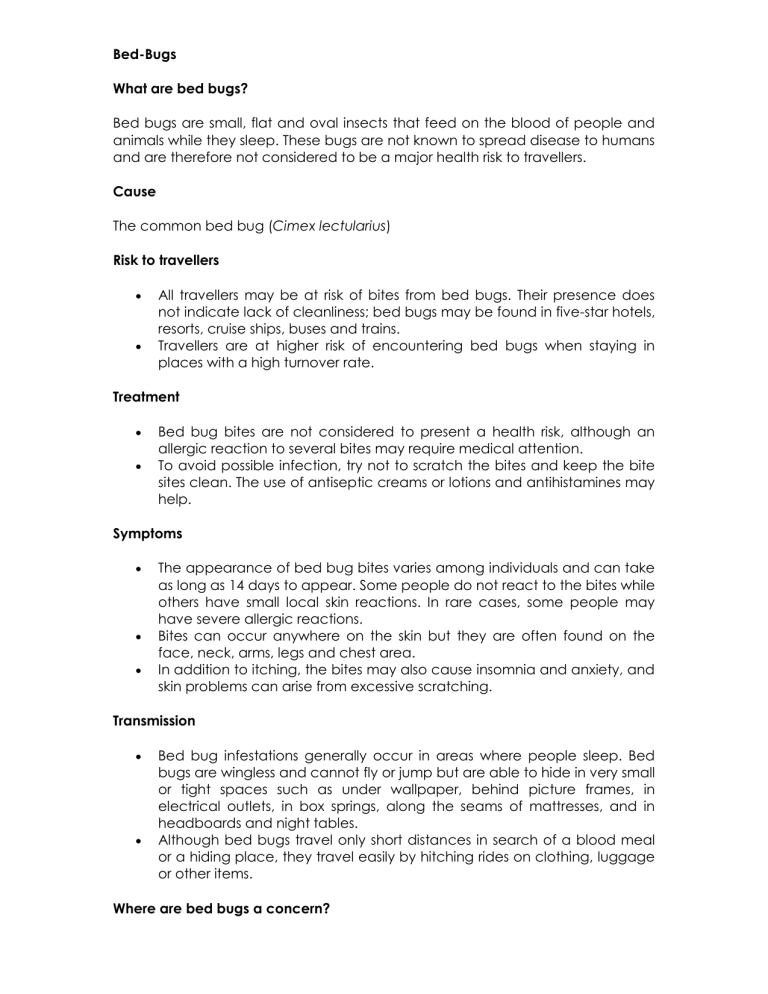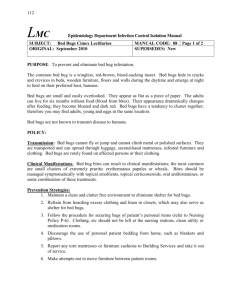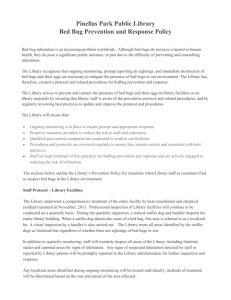Bed-Bugs - Global Medikit

Bed-Bugs
What are bed bugs?
Bed bugs are small, flat and oval insects that feed on the blood of people and animals while they sleep. These bugs are not known to spread disease to humans and are therefore not considered to be a major health risk to travellers.
Cause
The common bed bug (Cimex lectularius)
Risk to travellers
All travellers may be at risk of bites from bed bugs. Their presence does not indicate lack of cleanliness; bed bugs may be found in five-star hotels, resorts, cruise ships, buses and trains.
Travellers are at higher risk of encountering bed bugs when staying in places with a high turnover rate.
Treatment
Bed bug bites are not considered to present a health risk, although an allergic reaction to several bites may require medical attention.
To avoid possible infection, try not to scratch the bites and keep the bite sites clean. The use of antiseptic creams or lotions and antihistamines may help.
Symptoms
The appearance of bed bug bites varies among individuals and can take as long as 14 days to appear. Some people do not react to the bites while others have small local skin reactions. In rare cases, some people may
have severe allergic reactions.
Bites can occur anywhere on the skin but they are often found on the
face, neck, arms, legs and chest area.
In addition to itching, the bites may also cause insomnia and anxiety, and skin problems can arise from excessive scratching.
Transmission
Bed bug infestations generally occur in areas where people sleep. Bed bugs are wingless and cannot fly or jump but are able to hide in very small or tight spaces such as under wallpaper, behind picture frames, in
electrical outlets, in box springs, along the seams of mattresses, and in headboards and night tables.
Although bed bugs travel only short distances in search of a blood meal or a hiding place, they travel easily by hitching rides on clothing, luggage or other items.
Where are bed bugs a concern?
The common bed bug can be found worldwide.
Recommendations
Consult a doctor, nurse or health care provider, or visit a travel health clinic preferably six weeks before you travel.
Before you travel: o
Bring clear plastic bags with you that can be properly sealed to protect your clothing or luggage from possible infestation. o
A permethrin-treated bed net may be useful but not if the mattress is infested with bed bugs. o
Do not bring your pillow from home.
During your trip: o o
Inspect your room and if possible do not bring your luggage into the room until the inspection is completed. Check for signs of infestation such as black/brown spots (dried blood or feces), white spots (eggs – very difficult to see) or actual live or dead bed bugs on mattress and box spring seams, headboard, bed frame, cushions, pillows, side tables, chairs, picture frames, radios, phones, clocks, window and door casings.
To avoid bed bug infestation, do not put your suitcase on the bed or unpack your clothes. Place your luggage in a large clear plastic o bag and keep it away from the bed and the floor. You are best to keep it in a separate area of your room such as the bathtub or shower stall as these areas are not likely to be infested.
Place all worn and potentially affected clothes in a tightly sealed plastic bag until they can be washed and dried appropriately.
When you return: o
Before bringing your belongings into your home, thoroughly inspect your suitcase and all articles of clothing for bed bugs. o o o
Wash and dry your clothes on the hottest setting and vacuum your luggage, backpack and camera bag. Be sure to seal and discard the vacuum cleaner bag in the outside garbage.
It may not be necessary to treat items that cannot be laundered unless bed bugs are found. For those who wish to be extra cautious, some items can be placed in plastic bags or in plastic wrap and placed outdoors on hot sunny days or in sub-zero temperatures in the winter. Freezing temperatures must be maintained for at least four days; however this may not always be 100% effective.
If you have found bed bugs or have noticed bites in the days/weeks after your return, contact a pest management professional, who will be able to monitor and provide advice on possible treatment.
Source: http://travel.gc.ca/travelling/health-safety/bed-bugs








